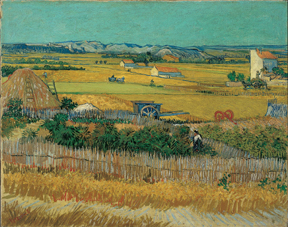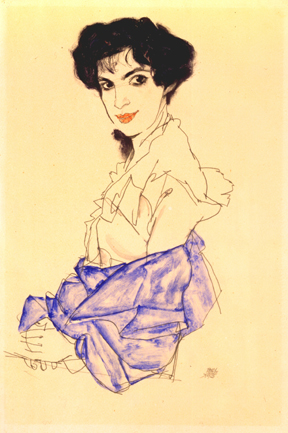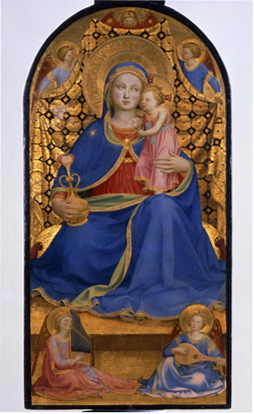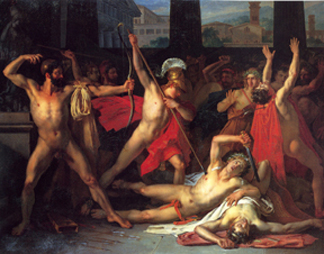By
RAYMOND J. STEINER
ART TIMES December 2005
|
|
ORGANIZED
BY THE Neue Galerie’s director, Renée Price, this exhibition* brings
together some 150 paintings and drawings gleaned from the extensive
collections of Ronald S. Lauder and Serge Sabarsky of the works of what
many have hailed as one of Austria’s “greatest artists of the 20th-Century”,
Egon Schiele. Ranging from his earliest academic work (see, e.g., Cat.
Nos. D1 thru D19) to his “mature” style (he only lived until the age
of 28) of figurative work in the expressionist mode, the exhibit is
spread over a number of spacious and well-lit galleries on two separate
floors of the Neue Galerie. Influenced by such forerunners as Vincent
van Gogh, Edvard Munch, Gustave Klimt, et al. who were responsible for
“liberating” art from what was perceived as the strait-jacket of academicism,
Schiele’s forte was depicting psychological portraits (self- and other-)
that in their impact on the viewer seem (as did those of many of the
so-called ‘expressionists”) anything but liberating. Lauded for revealing the ‘truth’ that lay
behind illusion, this was a truth that many found not only offensive,
but also as patently false as the saccharine-sweet “prettiness” of the
academics — at any rate, a truth that few would be willing to
own as their own. Whatever one may come away with after viewing a full
dose of Schiele’s distinctly individual vision of the human figure,
there can be no doubt that he was a masterful draftsman, able to forcefully
depict the most common objects (“A Plow”, Cat. No. D22), delineate a
delicate blossom (“Flower Studies (Bindweed, Poppies, and Daisies” Cat.
No. D168), or sensitively capture a meditative moment (“The Father-in-Law
Harms”, Cat. No. D134). In several of his drawings (Cat. Nos. D163 thru
D167), he seems hardly to lift his pencil, the figure drawings performed
almost through the use of a single, continuous line. Schiele, however,
had other ideas than to use his art as a simple means of reporting what
he saw — no matter how well he might be able to do just that.
His was a vision that had grown out of a personal confrontation with
a world that was quickly changing before his eyes. Indeed, had he lived
to witness it, he would have experienced his own celebrity transform
from one of acceptance to one of rejection, his work lumped together
with most of the expressionists by the Nazis under the all-condemning
“Entarte Art” — i.e., “degenerate” art. That he had obtained such
a powerful means of moving his viewers at such a relatively young age
leads one to wonder what he might have attained in the fullness of his
years. This is a powerful exhibition and, for better or worse, there
will be few who will be able to come away from it unmoved.
|
|
INTERESTING,
IN LIGHT of the previous look at the drawings of Schiele, is to view
those of Vincent van Gogh, one of the early artists that many of the
expressionists claimed as an influence on their own development (i.e. liberation). Some 113 works drawn from both private
and public collections around the world, the exhibit “Vincent van Gogh:
The Drawings”** presently set up in a special viewing area on the second
floor of The Metropolitan Museum of Art, offer a career-long overview
of the artist’s work. Here, as in the Schiele exhibit, we can easily
follow the move from straight “reporting” (“Windmills near Dordrecht
(Weeskinderendijk)” (Cat. No. 2), through interpretation (“Head of a
Woman” (Cat. No. 27); “the Zouave” (Cat. Nos. 77, 78, 79)) to a final
(mature) personal vision (“Cypresses” Cat. No. 108). Though there are
a few landscapes sprinkled throughout the Schiele exhibit, the Austrian
was by far more interested in the exploring the human figure and it
was in depicting them that he found his most powerful voice. Vincent
van Gogh, on the other hand, appears to have found his personal liberation
not so much in exploring what lies beneath the human façade, but rather
in seeking the mysterious underpinnings of an ever-changing natural
landscape. Where Schiele appears to uncover individual torment, van
Gogh appears to uncover the seething movement of energy that lies behind
‘solid’ matter. Again, it is obvious that both artists were capable
of rendering phenomena in the traditional academic way; equally obvious
is that both were intent on seeing the world in the light of their own
individual psyches. It is, in the end, irrelevant if one chooses the
vision of one over the other — what matters is if the viewer is
convinced that what one is seeing is forceful enough to speak the ‘truth’
of the creator as he, as artist, has seen and understood it. What each
individual viewer comes away with ultimately depends on what that viewer
believes is the purpose of art — or, in other words, his or her
own concept of what ‘truth’
is and how art ought to serve it. If not as “loudly” stated as Schiele’s
work, van Gogh (who doesn’t seem to exude as much of a whiff of the
psychoanalyst’s office for me), in his own quiet and plodding way, is
equally forceful in his message. Vincent van Gogh, of course, (as is
true of any great artist) deserves to be evaluated on the basis of his
own work and not in relation to that of another. Spending a few hours
or so browsing and allowing him to communicate with you is not a bad
way to while away an afternoon. Taking in both of these shows on the
same day can offer some interesting insights.
|
|
ALTHOUGH
ONLY A floor away in the Robert Lehman Wing at The Metropolitan Museum
of Art in, because of its difference in impact you might want to put
off visiting the Fra Angelico exhibit*** for another day. (In fact,
I rarely view more than a single exhibit on any given day, since I am
prone to becoming visually overloaded pretty quickly and am unable to
form clear conceptions if I overstep my limitations.) The first retrospective
of his work in America, “Fra Angelico” comprises some seventy-five of
his drawings, mss. illuminations, and paintings, and also includes forty-five
additional works by his assistants and followers — it is, therefore,
not only different in kind from the van Gogh show upstairs, but also
a lot to take in as well. To begin with, there is the subject matter.
Fra Angelico, as his name implies, was a Dominican monk (his ‘real’
name was Guido di Pietro, the “angelic friar” a nickname given him by
his contemporaries and followers), and his life’s work was given over
to imparting the teachings of Catholicism through the skill of his art.
Thus, instead of simple landscapes and figures, his subject-matter is
confined to heavenly figures and such earth-bound personages as popes,
saints, martyrs, and apostles. Unless one is devoted to the Dominican
friar’s pictorial history and dogma of the Roman church and is intent
on identifying his cast of characters, the uninitiated (or uninterested)
can focus on the work — gathered together from over fifty public
institutions and private collections in Europe and America — of
this extraordinary painter. Born in Florence, Fra Angelico’s skill with
the brush quickly brought him to attention both in and outside of the
church, and he was called upon to fulfill commissions for churches over
most of Italy. Though his reputation was largely made on the strength
of his frescos, the present exhibit offers a wide range of his smaller
works — almost all of which (and in spite of the repetition of
subject-matter) are little gems of perfection. If one is drawn to admiring
the skill displayed in painting so many multi-figured compositions in
miniature, it is (at least for this viewer) the color that is particularly
arresting. So vivid are the reds, blues, and golds that most seem to
have been painted yesterday. Technical skill, of course, was a hallmark
of the Italian Renaissance, and Fra Angelico was one of its leading
stars. How fortunate that we have so many examples from which we can
determine just how far they had grown in perfecting the art of painting
three-dimensional subjects on a two-dimensional surface. In today’s
artworld, such technical expertise is often given short shrift —
and the idea that one ought to be first a craftsman before one can claim
to be an artist, somewhat of an old-fashioned concept. Still, for all
their apparent “sameness” to the uninitiated eye, each one of these
painters — Lorenzo Monaco, Battista di Biagio Sanguigni, Zanobi
Strozzi (don’t miss his series of exquisite miniatures done in brush
and brown ink with white gouache and orange wash on pink-purple prepared
parchment) — Pesellino, Benozzo Gozzoli, as well as Fra Angelico
— is a master craftsman who has certainly done his homework. If
we really want to know what a “painter” is, visiting this exhibit will
more than inform you and enlighten you — it will delight your
sense of just what “fine” art is.
|
Louis-Vincent-Léon
Pallière, 1787-1820, “Ulysses and Telemachus |
WHICH
BRINGS US to the exhibit, “The Legacy of Homer.” The French Academicians
not only inherited the tradition of fine art painting from the Italian
Renaissance, but also expanded and built upon the principles of craftsmanship
by applying it to both their and, as this exhibition shows, ancient
civilizations. On loan to the Dahesh Museum of Art and the Princeton
Museum of Art from the Ecole des Beaux-Arts, this beautiful exhibit
of paintings, sculptures, etchings, and oil studies show what urging
a little bit of learning on the part of its artists might attain. Several
oil studies included in the show, in fact, are student competition pieces
meant for an exhibition designed to exemplify a particular theme found
in Greek literature, thus forcing the art student to look beyond his
own discipline (and time). The present show, incidentally, is itself
thematically organized by Greek subject matter: “”Historical Background”,
“The Gods”, “Achilles”, “The Fall of Troy”, etc. For me, visiting the
Dahesh Museum of Art is always a pleasant experience — as I am
sure it is for most appreciators of fine art. Dedicated as it is to
what they call a “radical reappraisal of 19th-Century art”,
the Dahesh has outdone itself with this outstanding representation of
the genre of representational art. On view for the first time in the
United States, for example, is Jaques-Louis David’s monumental (275
x 203cm) oil “La Douleur d’Andromaque sur le corps d’Hector” (Andromache
Mourning Hector), along with a host of France’s outstanding artists
(Paul Jourdy, Alexandre-Adolphe-Gustave Levasseur, Jean-Louis Brian,
Jean-Charles-Joseph Rémond, Henri Regnault, Jean-Baptiste Marty, Jean-Baptiste
Carpeaux, Alfred Edouard Lepère, Pierre-Jules Cavelier, Henri-Lucien
Doucet, Jules-Joseph Lefebvre, Charles-Louis Bazin, André Giroux, Hippolyte
Flandrin, Gustave Boulanger, among others) of the period. “The Legacy
of Homer” is a show in the grand style of the official French Salon,
painterly skill and erudition combined in a manner to impress and exalt
the human spirit. Whether we will or no, viewing these paintings takes
us far from the world we have since come to know — a world of
petty greed, quick fixes, and ignoble goals. In this world, Homer’s
world and the 19th-
Century of heroic painters, we
mere mortals hob-nob on an equal footing with the gods — being
human meant something back then and the French were not ashamed
to feel a part of that grander scheme. Oh, well — we’ve come a
long way, and most of that journey seems to have been downhill. Today’s
young artists seek markets and not honors. But then, the French knew
our frailties and foibles as well — and the Dahesh Museum is perhaps
not all that elitist as I seem to be making it out to be. They conclude
the exhibition with a section called “Homeric Laughter” and what could
be more poking fun at the pompier than a rackful of Honoré Daumier’s prints lampooning
the whole Greek mythos? If you like your elegance with a side order
of laughter, you’ll like this one.
*“Egon
Schiele: The Ronald S. Lauder and Serge Sabarsky Collections” (thru
Feb 20, ’06): Neue Galerie: Museum for German and Austrian Art, 1048
Fifth Ave., NYC (212) 628-6200.
**“Vincent
van Gogh: The Drawings” (thru Dec 31): The Metropolitan Museum of Art,
1000 Fifth Ave., NYC (212) 570-3951.
***“Fra
Angelico” (thru Jan 29): The Metropolitan Museum of Art, 1000 Fifth
Ave., NYC (212) 570-3951.
****“The
Legacy of Homer: Four Centuries of Art from The Ecole Nationale Supérieure
des Beaux-Arts, “Paris” (thru Jan 22): The Dahesh Museum of Art, Madison
Ave., NYC. A concurrent exhibit of the same name (thru Jan 15) is currently
at the Princeton University of Art Museum, Princeton, NJ.

 Vincent
van Gogh “Harvest in Provence”, ca. June 12, 1888
(oil on canvas) 73 x 92 cm (28-3/4 x 36-1/4 in.) Van Gogh Museum,
Amsterdam (Vincent van Gogh Foundation)
Vincent
van Gogh “Harvest in Provence”, ca. June 12, 1888
(oil on canvas) 73 x 92 cm (28-3/4 x 36-1/4 in.) Van Gogh Museum,
Amsterdam (Vincent van Gogh Foundation) Egon
Schiele, “Elisabeth Lederer,
Egon
Schiele, “Elisabeth Lederer,  Fra Angelico (Italian, ca. 1390/95-1455) Virgin and Child, with
Five Angels, ca. 1426/27 (Tempera on panel) Overall, 38-7/8
x 18-1/4 in., picture surface 37-3/8 x 18-1/4 in. Museu Nacional
d’Art de Catalunya, Barcelona, Spain, Collection Museo
Thyssen Bornemisza. Photo: Thyssen Bornemisza Collection, on
deposit in the Museu Nacional d’Art de Catalunya, Barcelona
Fra Angelico (Italian, ca. 1390/95-1455) Virgin and Child, with
Five Angels, ca. 1426/27 (Tempera on panel) Overall, 38-7/8
x 18-1/4 in., picture surface 37-3/8 x 18-1/4 in. Museu Nacional
d’Art de Catalunya, Barcelona, Spain, Collection Museo
Thyssen Bornemisza. Photo: Thyssen Bornemisza Collection, on
deposit in the Museu Nacional d’Art de Catalunya, Barcelona